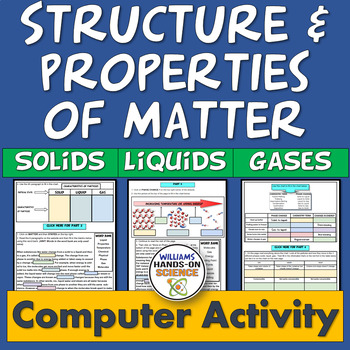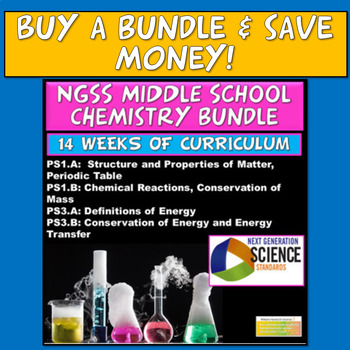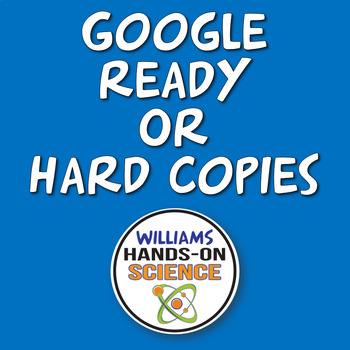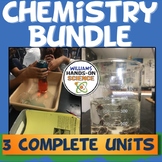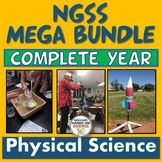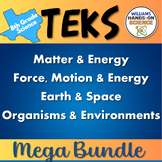States of Matter Worksheets Solids Liquids Gases Digital or Print NGSS MS-PS1
- Zip
- Internet Activities
Also included in
- This NGSS bundle has everything you need for Structure and Properties of Matter (complete distance learning unit), PS1.B PS3.A Chemical Reactions Google Ready Bundle (complete distance learning unit) Chemical Reactions, Definitions of Energy, States of Matter, Periodic Table, Chemical Reactions, ConPrice $69.97Original Price $115.20Save $45.23
- This bundle is a time-saving, comprehensive and user-friendly complete year bundle for physical science Teachers that will streamline your teaching experience effortlessly! Every lesson is meticulously planned and just a click away. This extraordinary bundle is a treasure trove of engaging resourcesPrice $176.00Original Price $311.50Save $135.50
- The TEKS 8th Grade Bundle is a comprehensive resource for teaching science mainly in Texas, but it can be used in any state. This bundle includes over 60 hands-on, rigorous, engaging, and phenomena-driven lessons that cover the TEKS standards for 8th grade science. The lessons are designed to help sPrice $160.00Original Price $321.15Save $161.15
Description
This lab is VIRTUALLY NO PREP! You will need a computer for each student or you can have students share a computer. You can use this to introduce the concepts, however I typically use it as a review. You can also pick and choose from the activities, I have the students do it in class during a 1 hour 45-minute period and most students finish in about an hour. I also include a KEY for easy grading and prep. This product is a total of 5 activities using some Chemistry websites and PHET University of Colorado Boulder Interactive Simulations that has 100’s of simulations to choose from.
THIS LAB INCLUDES THE FOLLOWING CONCEPTS: matter. mass, weight, states, phases, solids, liquids, gases, plasma, Bose-Einstein Condensates, characteristics of particles/molecules, temperature, energy, atoms, molecules, melting, freezing, vaporization, boiling, condensation, sublimation, deposition and real life examples to add context to content.
This resource is included in my Distance Learning NGSS PS1.A Structure & Properties of Matter Bundle.
This resource is now Google Ready for Distance Learning!!!
Please feel free to give me feedback and review my product.
Thank you so much!!!
Related Products
⭐ Chemical Reactions Stop Motion Movie & Jigsaw
⭐ Google Coronavirus Molecule Structure Claim Evidence Reasoning Distance Learning
⭐ Google Elements Atoms Compounds Molecules Card Sort Worksheet Distance Learning
⭐ Integrated NGSS MS-PS1-4: Heat Transfer, Conduction, Convection, Climate
⭐ MS-PS1-1: Bohr Model Atom Diagrams: Structure and Properties of Matter
⭐ MS-PS1-1: NGSS Periodic Table Computer Lab, Close Reading and Cloze Notes
⭐ MS-PS1-5: Chemical Physical Change Diet Coke & Mentos 5e Close Reading Modeling
⭐ MS-PS1-5: Chemical Reactions Simulation Conservation of Mass Close Reading Notes
⭐ MS-PS1-5: Conservation of Mass Chemical Reactions Online Close Reading & Notes
⭐ MS-PS1: Elements Atoms Compounds Molecules Card Sort Worksheet & Close Reading
⭐ MS-PS3-3 MS-PS3-4: NGSS Integrated Energy Lab Conduction Convection Radiation
⭐ NGSS 5E Conservation of Mass Lab Climate Change & Cloze Notes
⭐ NGSS 5E Matter Lab Computer Simulation Close Reading Close Notes & Warm Up
⭐ NGSS MS-PS1-1, MS-PS1-3, MS-PS1-4: Chemistry Warm Ups/Bell Ringers
⭐ NGSS MS-PS1-1: Molecule Building Lab Elements Atoms Compounds Molecules Formulas
⭐ NGSS MS-PS1-5: Chemical Vs. Physical Change Cart Sort Close Reading & Notes
⭐ NGSS PS1.A Magic Milk Lab Developing and Using Models Molecules Compounds
⭐ NGSS PS1.B Chemical Reactions Doodle Test Christmas
⭐ NGSS Structure & Properties of Matter Editable Study Guide & Test PS1.A PS3.A
⭐ NGSS Structure & Properties of Matter Study Guide Worksheet Graphic Organizer
⭐ NGSS Structure & Properties of Matter Vacuum in a Can Lab Modeling & Warm Up
⭐ PS1.A PS1.B Chemical Reactions Science Doodle Scaffolded Notes PowerPoint

